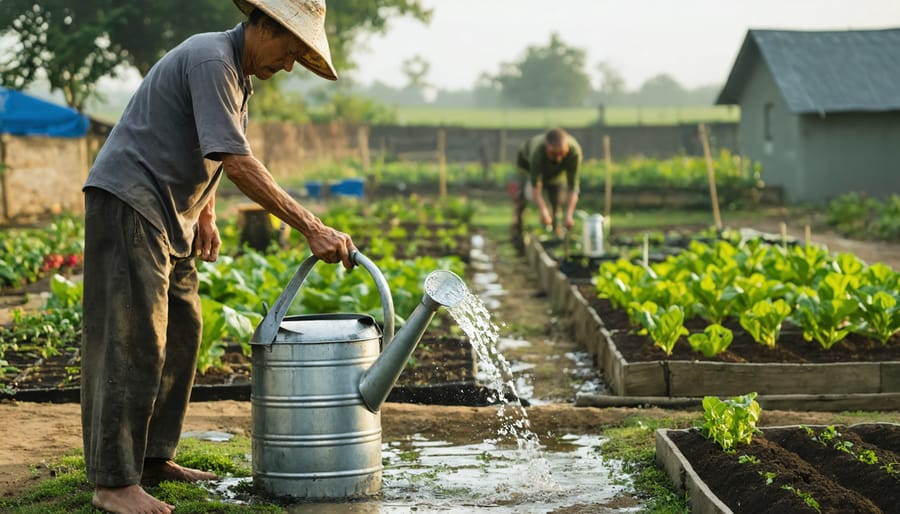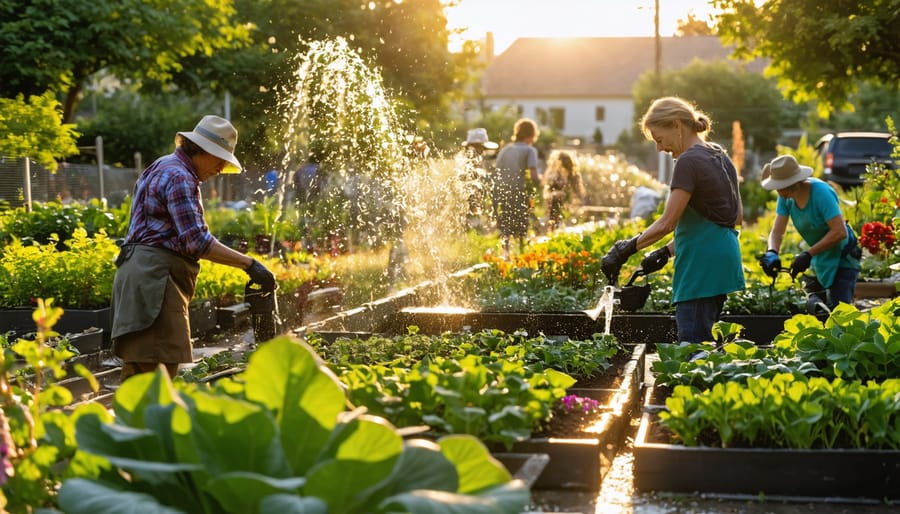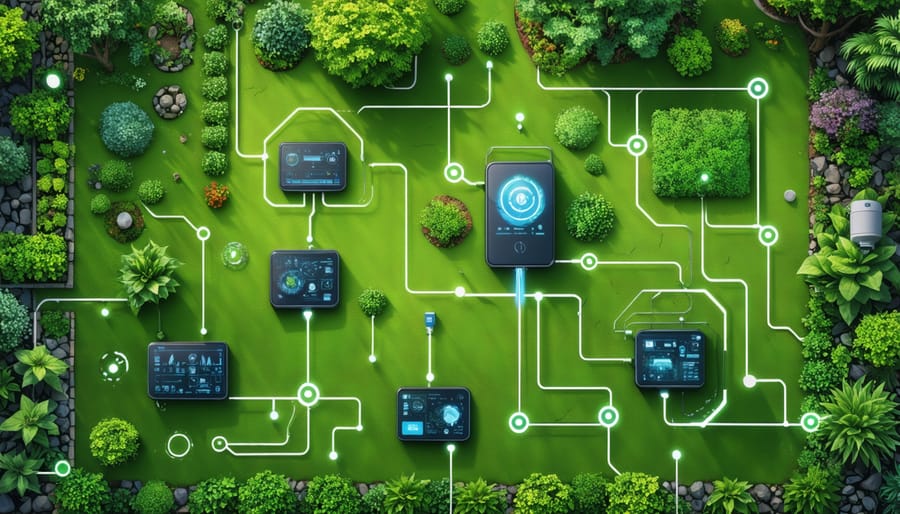Transform your garden into a water-saving oasis by creating your own managed aquifer recharge system. Like a natural savings account for water, these underground reservoirs collect and store rainwater during wet seasons, ensuring your plants thrive even during dry spells. Homeowners can participate in this sustainable practice through simple methods like installing permeable pavements, creating rain gardens, or building infiltration basins in their yards.
As water scarcity becomes a growing concern for gardeners worldwide, managed aquifer recharge offers a practical solution that combines traditional gardening wisdom with modern water conservation techniques. This natural approach not only supports healthier plant growth but also contributes to the broader community’s water security, reducing pressure on municipal water supplies and helping restore local groundwater levels.
By understanding and implementing managed aquifer recharge principles in your garden, you’re joining a movement of forward-thinking gardeners who recognize that sustainable water management starts in their own backyard. Let’s explore how you can make this powerful conservation technique work for your garden while supporting the environment around you.
Understanding Your Garden’s Water Source
What’s an Aquifer?
Think of an aquifer as nature’s underground water storage system – imagine a giant sponge made of rock, gravel, and sand hidden beneath our feet. These natural reservoirs store massive amounts of water in tiny spaces between rocks and soil particles, much like how water collects in the spaces of a sponge.
When it rains or snow melts, some of this water seeps down through layers of soil until it reaches these underground formations. The water fills up all the available spaces, creating a water-rich zone that we can tap into through wells. Some aquifers are just a few feet below the surface, while others can be hundreds of feet deep.
Just like a garden soil that’s rich in organic matter holds more water, different types of rock and soil affect how much water an aquifer can store. Some aquifers can hold billions of gallons of water, providing a crucial resource for gardens, farms, and communities during dry periods.

Why Your Garden Depends on Healthy Aquifers
Your garden’s success directly depends on the health of local aquifers, even if you’ve never given them much thought. These underground water reservoirs act like natural storage tanks, supplying the groundwater that keeps your soil moisture levels balanced throughout the growing season. When aquifers are depleted, your garden faces multiple challenges: deeper water tables make it harder for plant roots to access moisture, and wells may run dry during crucial growing periods.
A healthy aquifer system also helps prevent soil subsidence, which can damage your garden’s structure and drainage patterns. During dry spells, these underground reserves release stored water slowly, helping maintain soil moisture even when surface water is scarce. Additionally, well-maintained aquifers naturally filter water, ensuring your plants receive cleaner, mineral-rich moisture rather than potentially contaminated surface runoff.
By understanding this connection, you’re better equipped to make water-wise gardening choices that benefit both your plants and the larger ecosystem.
Simple Ways to Support Aquifer Recharge at Home
Rain Gardens and Bioswales
Rain gardens and bioswales are beautiful landscape features that play a crucial role in managed aquifer recharge while adding visual appeal to your garden. By installing a rain garden, you create a natural depression that collects and filters rainwater, allowing it to slowly seep into the ground rather than running off into storm drains.
To create your own rain garden, choose a location at least 10 feet from your house where water naturally collects. Dig a shallow basin about 4-6 inches deep, incorporating plenty of organic matter and native plants with deep roots. The best plants for rain gardens include moisture-loving species like rushes, sedges, and native wildflowers that can handle both wet and dry conditions.
Bioswales work similarly but are designed as long, gently sloping channels that direct water flow while filtering out pollutants. These features work particularly well along driveways or property boundaries where water tends to flow naturally. Layer your bioswale with gravel, sand, and rich soil, then plant it with hardy grasses and perennials that can withstand occasional flooding.
Both features require minimal maintenance once established – just regular weeding and occasional mulching to keep them functioning effectively. During heavy rains, you’ll love watching these garden features spring into action, knowing they’re helping replenish our precious groundwater supplies while creating habitat for local wildlife.

Permeable Surfaces
One of the most effective ways to support aquifer recharge in your garden is by incorporating permeable surfaces wherever possible. Instead of traditional concrete or asphalt, consider using materials that allow water to seep through naturally. Gravel pathways, for instance, not only add rustic charm to your garden but also help rainwater filter down to underground water stores.
Popular permeable options include crushed stone, permeable pavers, and recycled glass aggregates. For driveways, specially designed permeable concrete or interlocking pavers with gaps filled with small stones work wonderfully. These materials create tiny spaces between particles, allowing water to gradually percolate through while filtering out impurities.
When installing permeable surfaces, layering is key. Start with a base layer of larger stones, followed by progressively finer materials. This creates a natural filtration system that helps clean the water as it moves downward. For pathways, consider lining the sides with native plants that enjoy occasional wet feet – they’ll help absorb excess water during heavy rains.
Maintenance is surprisingly simple: occasional sweeping to prevent debris buildup and annual checking for compaction is usually sufficient. During rainy seasons, you’ll notice how quickly water disappears from these surfaces compared to conventional paving, reducing puddles and runoff while contributing to your local aquifer’s health.

Smart Garden Design for Water Conservation
Plant Selection for Water Efficiency
Selecting the right plants is crucial for maintaining soil moisture and supporting effective aquifer recharge in your garden. By implementing smart water-wise gardening practices, you can create a landscape that naturally preserves water while remaining beautiful and vibrant.
Deep-rooted native plants are excellent choices as they help maintain soil structure and create natural channels for water to penetrate deeper into the ground. Consider plants like Purple Coneflower, Black-Eyed Susan, and Little Bluestem, which have extensive root systems that can reach several feet below the surface.
Ground covers play a vital role in preventing soil moisture evaporation. Options like Creeping Thyme, Sedum, and native moss varieties create a living mulch that shields the soil while allowing water to percolate through. These plants also help prevent soil erosion during heavy rains.
Drought-resistant perennials like Lavender, Yarrow, and Russian Sage not only require less watering but also help maintain soil stability. Their presence encourages beneficial soil microorganisms that improve water retention and soil structure.
Remember to group plants with similar water needs together, creating hydrozones that make efficient use of available moisture. This thoughtful arrangement helps ensure that water reaches the right plants at the right time, maximizing the benefits for your local aquifer while maintaining a thriving garden ecosystem.
Soil Management Techniques
Good soil management is crucial for effective aquifer recharge in your garden. By improving your soil’s structure, you can enhance its ability to absorb and retain water, making it easier for rainfall and irrigation to reach underground water sources.
Start by adding organic matter like compost, leaf mold, or well-rotted manure to your soil. These materials create spaces between soil particles, allowing water to filter through more effectively. Think of it as creating tiny pathways for water to travel deeper into the ground.
Avoid compacting your soil by minimizing foot traffic in garden beds and using designated pathways. Consider creating raised beds, which naturally maintain better soil structure and drainage. Adding mulch on top of your soil also helps prevent compaction from heavy rain while reducing water evaporation.
Cover crops are another excellent tool for soil management. Plants like clover, rye, or vetch help break up compacted soil with their roots while adding organic matter when turned under. They also protect the soil surface from erosion during heavy rains.
For clay-heavy soils, gradually incorporate sand and organic matter to improve drainage. In sandy soils, focus on adding organic matter to increase water retention. Remember that healthy soil management is a gradual process – small, consistent improvements will lead to better water infiltration over time.
By maintaining good soil structure, you’re not just helping your garden thrive; you’re also contributing to the natural water cycle and supporting local aquifer recharge.
Community Benefits of Managed Aquifer Recharge
When homeowners and gardeners participate in managed aquifer recharge practices, they contribute to a network of benefits that extends far beyond their property lines. By allowing rainwater to seep naturally into the ground through rain gardens, permeable surfaces, and strategic landscaping, we collectively help maintain healthy groundwater levels that serve our entire community.
These individual efforts add up to create more resilient local water supplies, particularly during drought periods when surface water may be scarce. Communities with well-maintained aquifers often experience more stable water rates and fewer restrictions during dry seasons, as they can rely on their underground reserves.
The environmental benefits ripple throughout the neighborhood too. Well-recharged aquifers help sustain local streams and wetlands, creating vibrant ecosystems that support wildlife and enhance our outdoor spaces. They also help prevent land subsidence – the gradual sinking of ground that can damage buildings and infrastructure when aquifers are depleted.
From a practical standpoint, communities with active aquifer recharge practices often see reduced flooding during heavy rains, as the ground is better equipped to absorb excess water. This means less strain on municipal storm drainage systems and fewer flooded basements or waterlogged gardens.
By participating in managed aquifer recharge, we’re not just helping ourselves – we’re contributing to a sustainable water future for our entire community, creating a legacy of water security for generations to come.
As gardeners, we have the unique opportunity to become stewards of our local water resources through managed aquifer recharge practices. By implementing simple techniques like rain gardens, permeable surfaces, and strategic water collection systems, we can contribute to the health of our underground water supplies while creating more resilient gardens. Every drop we help return to our aquifers makes a difference, not just for our own gardens but for our entire community’s water security. Start small by adding a rain garden or switching to permeable pathways, and gradually expand your water-wise practices. Together, we can nurture both our gardens and the precious water resources beneath our feet. Remember, healthy aquifers mean thriving gardens for generations to come. Why not take that first step today?




